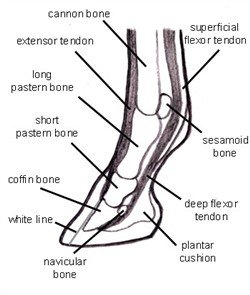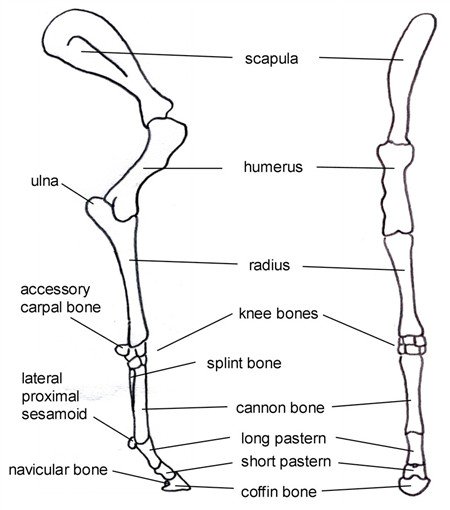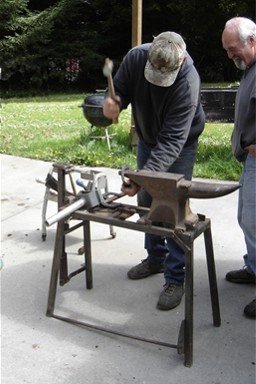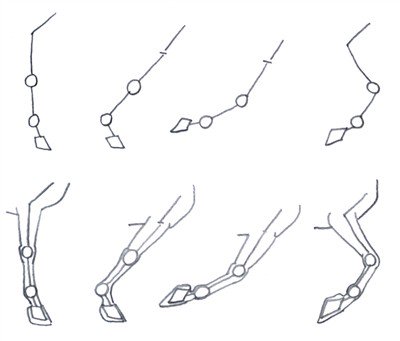How Equine Forelimb Anatomy
Works with Conformation and Soundness
Equine forelimb anatomy is key to the performance ability of every horse. The front legs support nearly two thirds of the weight of a horse. Any conformation faults here will contribute greatly to lameness and injury of these weight bearing forelimbs.
Common Forelimb Injuries
- splints
- navicular disease
- bowed tendons
- knee injuries
- laminitis
- windpuffs
- ringbone
- arthritis
- fractures
Many of these forelimb injuries have to do with the high level of weight and concussion that the leg is subject too. All conformation flaws reduce the ability of the joints to absorb shock, thus over stressing the bones and ligaments.
Over time, repeated stresses of heavy weight and impact take their toll on the joints and surrounding tissues. A horse with flawed conformation will break down much faster.
Equine Forelimb Anatomy – The Upper Leg
Equine Forelimb Anatomy Fact
The front legs of a horse are not attached to the spine, but rather held in place by a 'girdle' or sling of muscles.
The uppermost bone in the foreleg is the scapula, or shoulder blade. The point of the shoulder and the shoulder blade make up the angle of the shoulder, which should be about a 45º angle. The scapula connects to the humorous with a ball and socket type joint. The humorous connects to the radius. Neither of them connect to the spine.
The radius is the bone that makes up the forearm of the horse. It should be longer in comparison to the cannon bone. A strong front leg will have a long forearm and a short cannon bone.
The tip of the radius is called the ulna, or the elbow of the horse. The elbow should sit directly below the front of the withers. An elbow that is turned in or out puts extra strain on the fetlock joint. A turned in elbow is called ‘tied in’, and tends to shorten the stride; while a turned out elbow makes a horse ‘paddle’ (throw his feet to the side).
Cowboy character Lucas McCain from the hit T.V. Show the 'Rifleman' rode a black horse that paddled terribly with both front feet.


Equine Forelimb Anatomy – The Lower Leg
The knee is made up of 8 small bones that sit between the radius and the cannon bone. A well shaped knee should be large and flat from the front and wide from the side. The carpal bone that is visible at the back if the knee should be well defined. The knee should sit directly over the cannon bone. Knees should not be bowed or knocked, nor set too far forward or back when viewed from the side.
The knee is made up of 8 small carpus bones in two rows of four.
The cannon bone should be relatively short in length and straight up and down. The small splint bone runs partially down the side of the cannon bone. When viewed from the side the cannon bone is wider than when seen from the front. A long cannon bone puts undue stress on the knee joint and tendons. The cannon bone in the frond legs will be shorter than the cannon bones in the back legs.
The long pastern bone and the cannon bone come together to form the fetlock joint. The fetlock joint is hugely important as a shock absorber. It takes a vast amount of stress. This joint should be relatively large, but not so large as to show any signs of damage.
A horse has no muscles below the knee, only ligaments and tendons.
The long pastern bone and short pastern bones come together to form the pastern, the area between the fetlock joint and the top of the hoof. This joint should be sloped at a 47º- 55º angle. Excessive sloped pastern puts too much strain on ligaments and the horse is prone to bowed tendons and navicular disease. Too upright a pastern gives a horse a choppy gait. Pasterns that are too short make a horse prone to navicular disease, windpuffs, splints, knee injuries, splints, ringbone and arthritis.
Lastly the petal or coffin bone and the tiny navicular bone make up the portion of the horse leg bones inside the horse’s hoof.
Equine forelimb anatomy sets the tone for the agility, endurance and speed of a horse. The closer you can get to an ideal front leg conformation the less prone your horse will be to injury.
More Equine Leg Articles:
Home > Horse Anatomy > Equine Forelimb Anatomy



